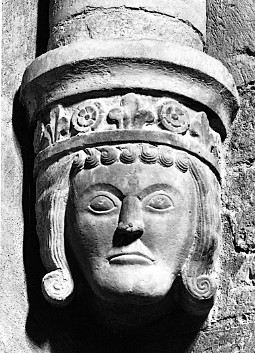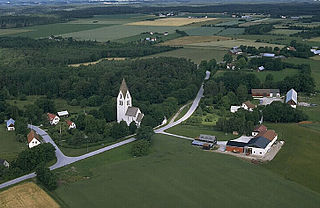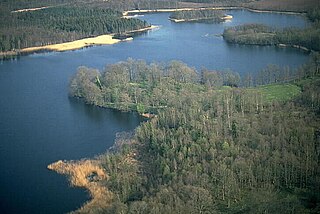
Magnus III, also called Magnus Ladulås, was King of Sweden from 1275 until his death in 1290.

Birger Jarl, also known as Birger Magnusson, was a Swedish statesman and regent, jarl, and a member of the House of Bjelbo, who played a pivotal role in the consolidation of Sweden. His first marriage was to Princess Ingeborg of Sweden, which created his base of power. Birger led the Second Swedish Crusade, which established Swedish rule in Finland. Additionally, he is traditionally attributed with the foundation of the Swedish capital, Stockholm, around 1250. Birger used the Latin title of Dux Sweorum, and the design of his coronet combined those used by continental European and English dukes.

Valdemar I Knudsen, also known as Valdemar the Great, was King of Denmark from 1154 until his death in 1182. The reign of King Valdemar I saw the rise of Denmark, which reached its medieval zenith under his son King Valdemar II.

Valdemar or Waldemar was King of Sweden from 1250 to 1275.

Magnus Haakonsson was King of Norway from 1263 to 1280. One of his greatest achievements was the modernisation and nationalisation of the Norwegian law-code, after which he is known as Magnus the Law-mender. He was the first Norwegian monarch known to have used an ordinal number, although originally counting himself as "IV".

TorkelKnutsson was Lord High Constable of Sweden, member of the Privy Council of Sweden (Riksråd), and virtual ruler of Sweden during the early reign of King Birger Magnusson (1280–1321).

Birger was King of Sweden from 1290 to 1318.

The Battle of Lund, part of the Scanian War, was fought on December 4, 1676, in an area north of the city of Lund in Scania in southern Sweden, between the invading Danish army and the army of Charles XI of Sweden. The Danish had an army of about 13,000 under the personal command of 31-year-old King Christian V of Denmark, aided by General Carl von Arensdorff. The Swedish army, which numbered about 8,000, was commanded by Field Marshal Simon Grundel-Helmfelt and the 21-year-old Swedish king Charles XI. It is one of the bloodiest battles in percent of casualties on both sides ever fought in Scandinavia.

The Nyköping Banquet was King Birger of Sweden's Christmas celebration 11 December 1317 at Nyköping Castle in Sweden. Among the guests were his two brothers Duke Valdemar and Duke Eric, who later that night were imprisoned and subsequently starved to death in the dungeon of Nyköping Castle.
The Håtuna games were a 1306 conflict between Birger, King of Sweden (1280–1321) and his two brothers, the dukes Eric Magnusson and Valdemar Magnusson .

Bishop Benedict, Duke of Finland was a Swedish prelate bishop and duke.

Sophia of Denmark was Queen of Sweden as the consort of King Valdemar.

Hedwig of Holstein or Helvig(Swedish: Helvig, German: Helwig) was Queen of Sweden as the consort of King Magnus III Barnlock. Her parents were Gerhard I, Count of Holstein-Itzehoe and Elisabeth of Mecklenburg.
Battle of Mared was a battle during the Nordic Seven Years' War between the Swedish and Danish forces on 9 November 1563. The battle was held on the site of present-day locality Oskarström in Sweden.

Mästerby is a populated area, a socken or administrative parish, on the Swedish island of Gotland. It comprises the same area as the administrative Mästerby District, established on 1 January 2016.

Duke Erik Birgersson was a Swedish duke of the House of Bjelbo (Folkungaätten).
The 6000-mark war was a war between Denmark and Sweden which took place from 1276 to 1278. It started because of a disagreement over an agreed sum of 6,000 silver marks for Danish assistance to Magnus Birgersson in the battle against Valdemar Birgersson in 1275.

Axevalla House is the ruins of a medieval castle in the parish of Skärv in the municipality of Skara, Västergötland, Sweden. It is located on a headland by Lake Husesjön, east of the heathland of Axevalla Hed and halfway between the cities Skara and Skövde.

The Danish Civil Wars were a series of civil wars fought in the Kingdom of Denmark, first from 1131 to 1134 over the murder of Canute Lavard, then from 1139 to 1143, and finally a war of succession fought from 1146 to 1157, after the abdication of Eric III of Denmark, the first monarch in Danish history to have abdicated. The first phase of the war was fought between King Eric II of Denmark and King Niels joined by Magnus the Strong. The second phase of the war was fought between the son of Magnus the Strong, Canute V of Denmark, the son of Eric II of Denmark, Sweyn III of Denmark, and his cousin Valdemar I of Denmark, son of Canute Lavard. The civil wars marked an increase in the influence of the Holy Roman Empire in Denmark, and for a time after, Denmark was a vassal state of Emperor Frederick I. The war ended with the deaths of seven kings. Two of the kings, Olaf Haraldsen and Magnus the Strong, are not amongst the official Danish line of kings. The other kings are Niels I, Eric II, Eric III, Canute V and Sweyn III.
Events from the 13th century in Denmark.
















